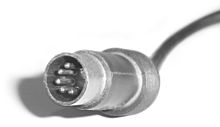- DIN sync
-
The SYNC standard, often called "DIN sync" or "sync24" (more rarely "sync48"), defines an interface for electronic music instruments. It was introduced in the 1980s by Roland Corporation for synchronization of music sequencers, drum machines, arpeggiators and similar devices. The SYNC standard uses the signals clock (or tempo) and start/stop (or run/stop). The signals are TTL compatible. This means the low state is 0 V, the high state is about +5 V. The clock signal (2.51 V, 24ppqn for Roland gear) defines the speed of the sequence or drum pattern. The start/stop signal defines if the sequence is running (start/stop = 0 V → stop, start/stop = +5 V → running).
The SYNC standard uses 5 pin DIN connectors, the same as used for MIDI, but uses a different pin-out. The term "DIN sync" does not mean that it is a DIN standard, only that it uses DIN connectors. In some applications the remaining pins (4 and 5) are even used as "tap", "fill in" or "reset and start". But this differs from device to device.
To connect two SYNC devices a cable with a 3 or 5 pin plug on each side has to be used. The pins 1, 2 and 3 have to be connected (in contrast to MIDI that uses the pins 4, 5 and 2). A standard MIDI cable is not suitable as pins 1 and 3 may be unconnected.
SYNC Input/Output: Some SYNC devices have SYNC In and SYNC Out sockets Others have only one socket that can be switched between input and output (e.g. Roland TR-808). The third group uses switched sockets. This means that the socket is switched to input if a plug is inserted (e.g. Roland TB-303). If you want to use this socket as output a special plug without ring has to be used as the ring of the plug operates the switch. For details refer to the user's manual or service manual of the specific device.
Roland DIN sync uses 24 pulses per crotchet (quarter note), hence the term 24ppqn. Korg equipment such as the DDM-110 drum machine uses an otherwise-identical system but at 48ppqn. If you plug a Roland TB-303 into a Korg DDM-110, the TB-303 will run at twice the normal speed. It is possible to overcome this with a simple adaptor.
See also
External links
Categories:- Synchronization
- Electronic musical instruments
Wikimedia Foundation. 2010.

